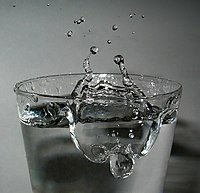
Back Chemiese verbinding Afrikaans Chemische Verbindung ALS Compuesto quimico AN यौगिक ANP مركب كيميائي Arabic مركب كيماوي ARY مركب كيماوى ARZ ৰাসায়নিক যৌগ Assamese Compuestu químicu AST Kimyəvi birləşmə Azerbaijani
A chemical compound is a chemical substance composed of many identical molecules (or molecular entities) containing atoms from more than one chemical element held together by chemical bonds. A molecule consisting of atoms of only one element is therefore not a compound. A compound can be transformed into a different substance by a chemical reaction, which may involve interactions with other substances. In this process, bonds between atoms may be broken and/or new bonds formed.
There are four major types of compounds, distinguished by how the constituent atoms are bonded together. Molecular compounds are held together by covalent bonds; ionic compounds are held together by ionic bonds; intermetallic compounds are held together by metallic bonds; coordination complexes are held together by coordinate covalent bonds. Non-stoichiometric compounds form a disputed marginal case.
A chemical formula specifies the number of atoms of each element in a compound molecule, using the standard chemical symbols with numerical subscripts. Many chemical compounds have a unique CAS number identifier assigned by the Chemical Abstracts Service. Globally, more than 350,000 chemical compounds (including mixtures of chemicals) have been registered for production and use.[1]
- ^ Wang, Zhanyun; Walker, Glen W.; Muir, Derek C. G.; Nagatani-Yoshida, Kakuko (2020-01-22). "Toward a Global Understanding of Chemical Pollution: A First Comprehensive Analysis of National and Regional Chemical Inventories". Environmental Science & Technology. 54 (5): 2575–2584. Bibcode:2020EnST...54.2575W. doi:10.1021/acs.est.9b06379. hdl:20.500.11850/405322. PMID 31968937.

